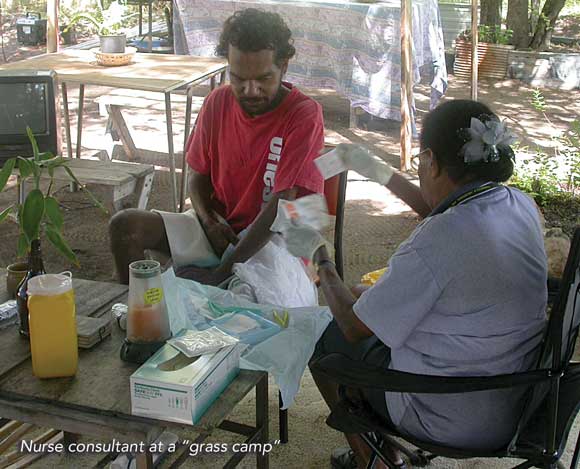As Indigenous CEOs, we train non-Indigenous doctors in cultural safety, and rely on them to integrate Aboriginal health workers into the multidisciplinary team
Aboriginal community controlled health services (ACCHSs) are generally managed through an elected board of directors and an appointed chief executive officer (or equivalent).
The reasons for choosing to work in this area are varied and are driven by personal, organisational and community goals. This is consistent with the findings of a report based on interviews with 41 Aboriginal and Torres Strait Islander health managers.1 The report revealed that the distinctive features of the managers include:
a very strong personal motivation to assist the Aboriginal and Torres Strait Islander community;
a willingness to take on a leadership role and initiate change within the community;
a direct sense of responsibility and accountability to the community; and
a desire to work outside the bureaucratic processes that often create barriers to success.

The accessibility of health services for Aboriginal and Torres Strait Islander peoples is affected by a number of factors, including the distance to and availability of health professionals. The employment of Aboriginal and Torres Strait Islander staff has long been recognised as an important factor in accessibility of services. Unpublished data from the Department of Health and Ageing and the National Aboriginal Community Controlled Health Organisation suggest that in 2000–01, 67% of full-time equivalent positions in federally funded Aboriginal primary health care services were held by Aboriginals and Torres Strait Islanders. However, examination of the workforce composition shows that most Indigenous staff (97%) were employed as health workers or field workers, while non-Indigenous staff were more likely to be employed in professional positions. Most doctors (98%), nurses (87%), allied health professionals (89%) and dentists (88%) were non-Indigenous.2 Therefore, in the Aboriginal medical services, there may be three strata of employees. Tsey has described the pyramid structure of most of the services, with a small group of Aboriginal managers at the top of the pyramid, a middle stratum occupied by predominantly non-Aboriginal professional staff, and a bottom stratum of predominantly Aboriginal workers who occupy semi- or non-professional roles.3 Thus, the CEO is faced on the one hand with the need to train their non-Indigenous staff in cultural safety, and on the other hand must rely very heavily on them for service provision and integration of Aboriginal health workers into the multidisciplinary team. Similarly, the CEO might be obliged to act as a manager for an Indigenous relative or close community member.
The model has features in common with the community controlled primary health care services that have contributed to health gains in other indigenous peoples. International comparative analyses4,5 demonstrate the success of community controlled models of health care, when governments have been engaged in the development of effective and efficient systems. For example, through the 1976 Indian Health Care Improvement Act in the United States, appropriated resources were used to expand health services, build and renovate medical facilities, provide safe drinking water and sanitary disposal facilities, and establish programs to increase the number of Native American health professionals.4
The first of a series of reports on expenditure on Indigenous health identified the specific areas in which spending inequities have occurred.6 As a result, major reforms and changes have been implemented. However, achieving a balance between time allocation for strategic initiatives and meeting acute clinical care needs remains a major challenge within many services.
- Cindy Shannon1
- Adrian Carson1
- Rachel C Atkinson2,1
- Townsville Aboriginal and Islanders Health Services, Townsville, QLD.
- 1. Wakerman J, Matthews S, Hill P, Gibson O. Beyond charcoal lane: Aboriginal and Torres Strait Islander health managers — issues and strategies to assist recruitment, retention and professional development. Alice Springs, NT: Centre for Remote Health, 2000.
- 2. Australian Bureau of Statistics, Australian Institute of Health and Welfare. The health and welfare of Australia’s Aboriginal and Torres Strait Islander peoples. Canberra: ABS, AIHW, 2003. (ABS Catalogue No. 4704.0, AIHW Catalogue No. IHW 11.) Available at: http://www.aihw.gov.au/publications/index.cfm/title/9226 (accessed Apr 2006).
- 3. Tsey K. Aboriginal self-determination, education and health: towards a radical change in attitudes to education. Aust N Z J Public Health 1997; 21: 77-83.
- 4. Kunitz SJ, Brady M. Health care policy for Aboriginal Australians: the relevance of the American Indian experience. Aust J Public Health 1995; 19: 549-558.
- 5. Ring I, Firman D. Reducing Indigenous mortality in Australia: lessons from other countries. Med J Aust 1998; 169: 528-533. <MJA full text>
- 6. Deeble J, Mathers C, Smith L, et al. Expenditures on health services for Aboriginal and Torres Strait Islander people. Canberra: National Centre for Epidemiology and Population Health and the Australian Institute of Health and Welfare, 1998.




